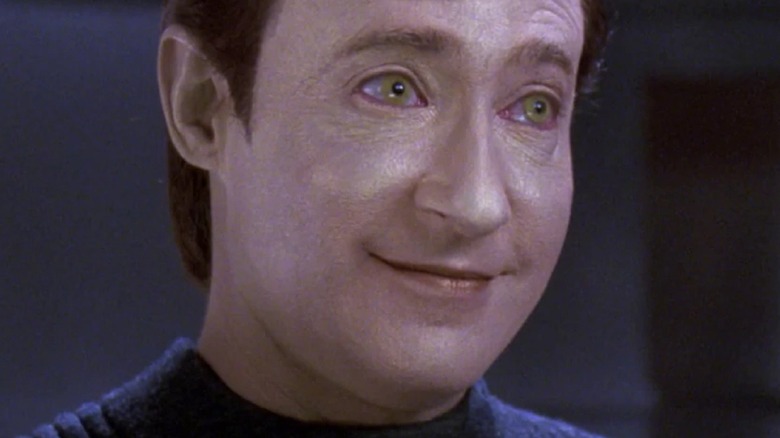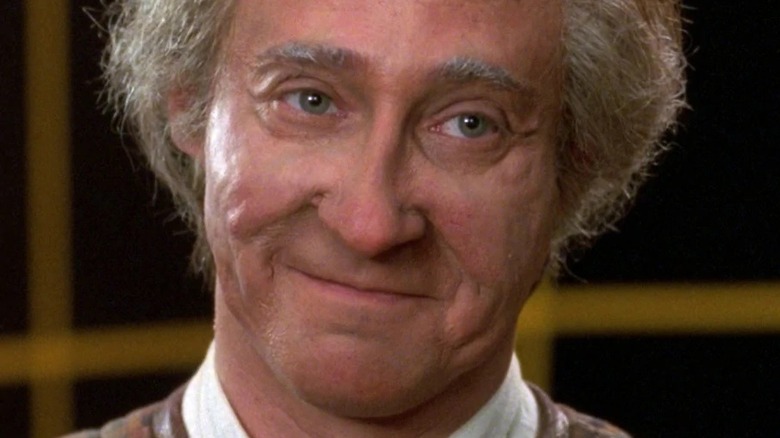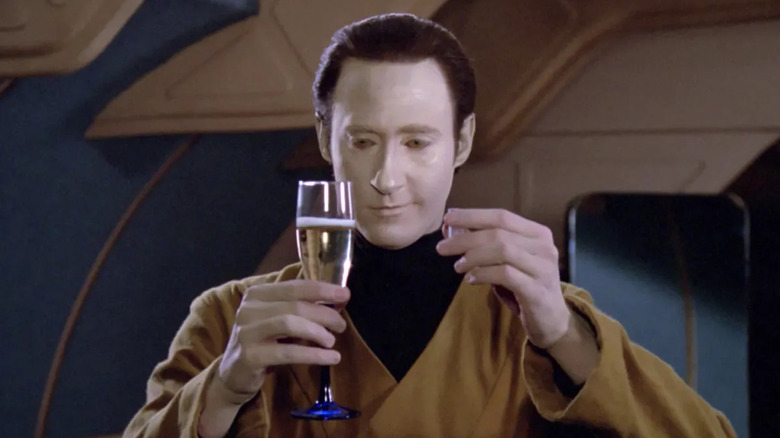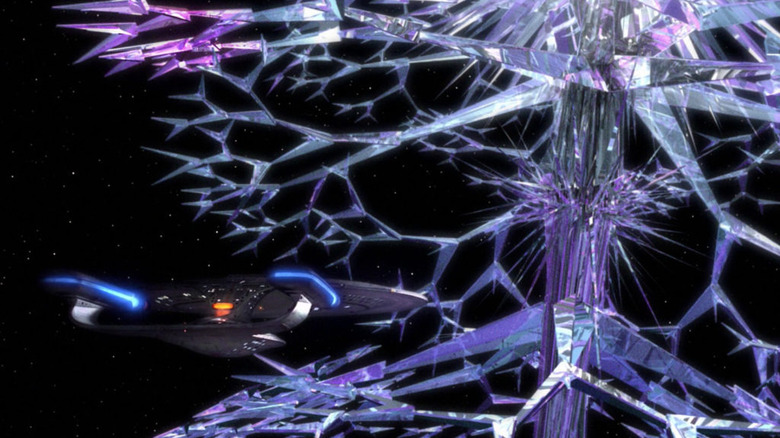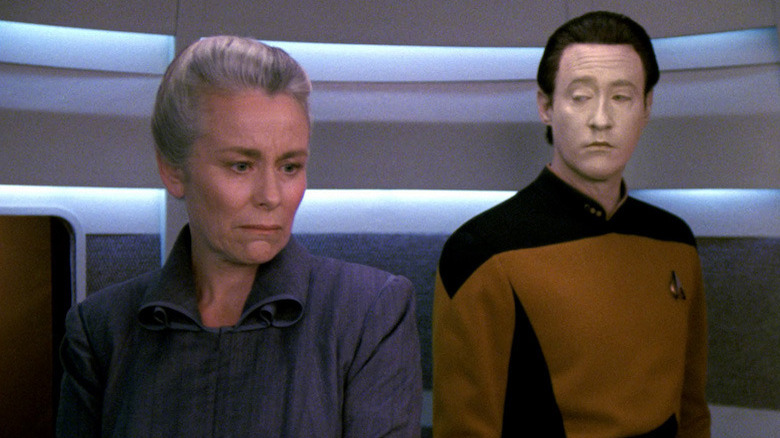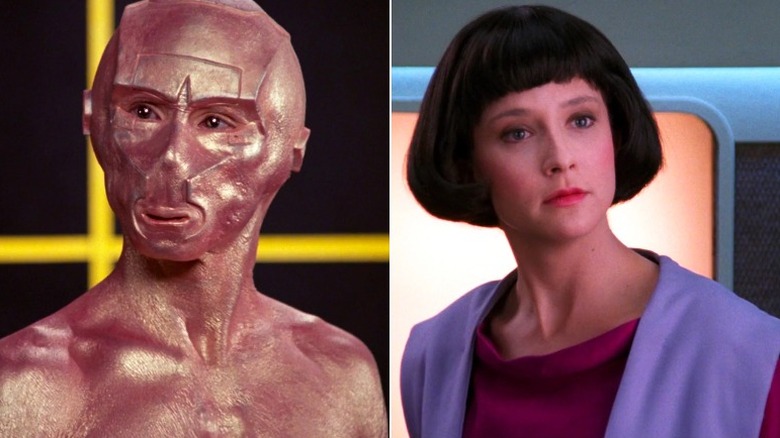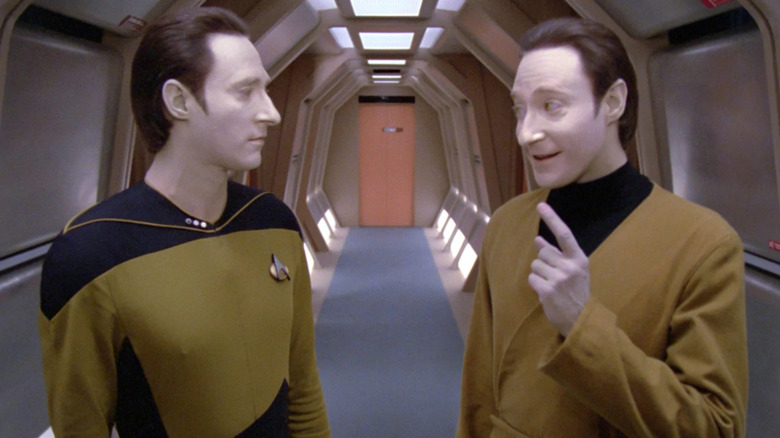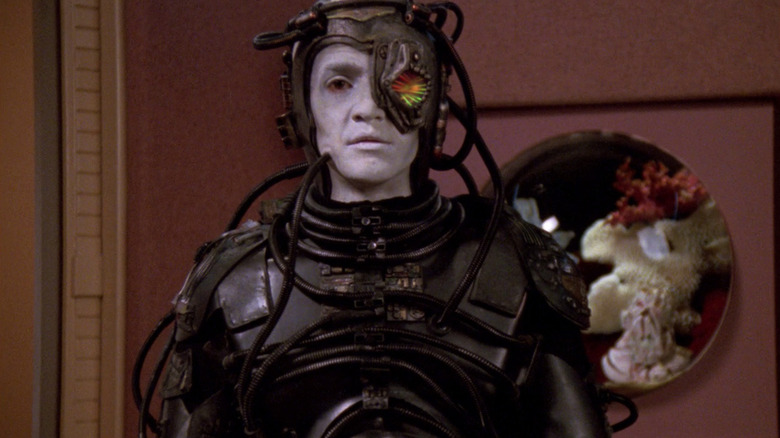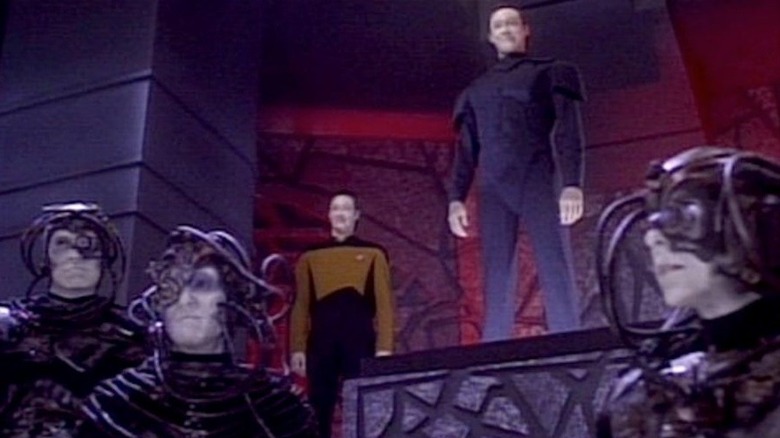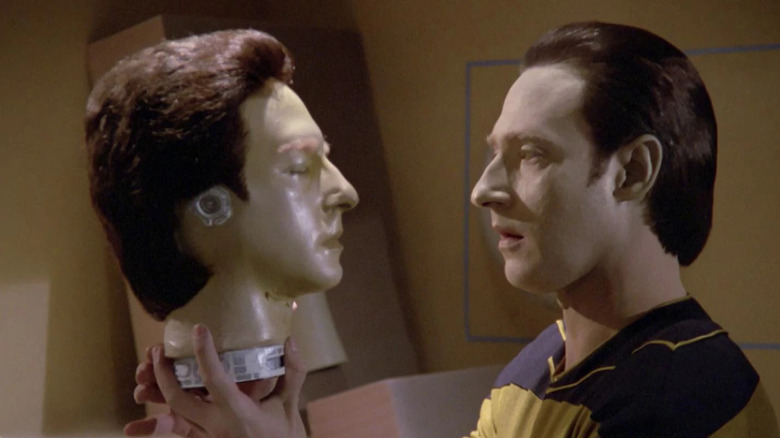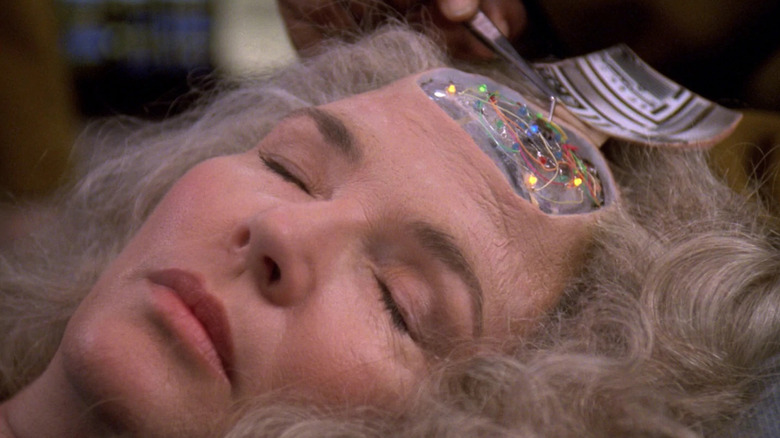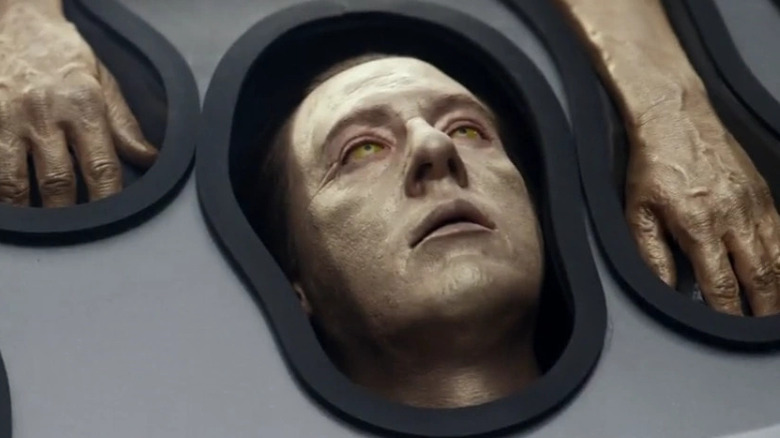Lore's Entire Backstory Explained
Every "Star Trek" series seems to have its own version of Spock, someone who doesn't understand (or cannot feel) emotions in the traditional sense. On "Star Trek: The Next Generation," that character is the beloved synthetic human Data (Brent Spiner), though Data also has elements of another famous "Star Trek" character. According to producer Robert H. Justman (via "The Fifty-Year Mission: The Next Twenty Five Years"), Data was envisioned as "an android programmed by Starfleet Command with all of the familiar abilities and characteristics of Spock fused with the leadership and humanistic qualities of Captain Kirk."
For seven seasons, Data played a major part in the show's explorations of selfhood, intelligence, and emotion. One plan to explore these feelings was to give Data a love interest. Her job was supposed to be repairing the ship in dangerous situations. Instead, "Star Trek" creator Gene Roddenberry decided to go down the evil twin route, and so the Lore that we know — also played by Spiner — was born. He's clever, mean, quirky, and very funny to watch, but with a lurking malevolence that's impossible to ignore. Let's take a look at his backstory.
The Soongs
The story of Data and Lore begins on the Omicron Theta colony, where Doctor Noonian Soong and his wife Juliana built a series of androids: Two basic prototypes, the simplistic model B-4, Lore, and Data. These were the first true fully functioning "positronic brains," which is the show's explanation for artificial intelligence in android form, and which is politicized, in various ways, throughout the canon.
The four Omicron Theta creations are known as "Soong-type" androids, because they are made in Dr. Soong's image (Dr. Soong, of course, is also played by Brent Spiner). Soong and Juliana considered all four of them their children, and Data and his fellow Soong-types are often referred to and behave as brothers. The Soongs also have a biological son, Altan Inigo Soong, graced with the same brilliance as his parents and brothers. He is introduced much later in the "Star Trek: Picard" series.
Thanks to Data's fame as the first android in Starfleet, Soong's research is further developed by Dr. Bruce Maddox, who goes into hiding after synthetics attempt to conquer Mars and synthetic life is subsequently banned. He and Agnes Jurati work with Noonian's son to create a whole community of organic androids based on Data's positronic neurons.
Creating Lore
When we first meet Lore on Omicron Theta, he claims to be an improvement on Data, but that turns out to be a lie: He is Data's older brother, not younger. Lore was born extremely advanced, with great strength and speed and high intelligence. He was also, unfortunately, unstable from the jump and he developed a serious superiority complex.
Later, Lore would claim he was rejected for being "too perfect," but the truth is that he's flawed in many ways. The people of the colony demanded that Noonian shut Lore down because he was creeping everybody out. In response, Lore secretly contacted a planet-killing space creature called the Crystalline Entity to come and destroy all life on the planet — excluding himself, of course.
Noonian eventually gave in to the demands of his fellow colonists and deactivated Lore. He stored Lore away and started work on Data instead. Since Lore's emotions were the core of his terrible behavior, Noonian decided Data would be created without all that mess — and he promised himself he would come back and fix Lore later. Noonian later came to feel bad about leaving Data's emotions out and created an "emotion chip" for him, but it took a long time for Data to actually receive and initiate it.
Meeting Lore
Unfortunately, Lore's deactivation doesn't take place soon enough for the colony to avoid the consequences of his actions, and the Crystalline Entity destroys all life on Omicron Theta. Data is discovered by the crew of the USS Tripoli years after the disaster, while Lore remained in Noonian's lab. An away team including Dr. Beverly Crusher comes from the USS Enterprise-D, and they are able to reactivate him.
Lore plays the part of a kind brother to Data at first, sharing stories about Soong, although we see in a few tics and quirks that indicate he's not entirely stable. We soon learn that he's lying about being created after Data rather than before. He isn't a more advanced model, as he would have people believe. That truth is that Soong saw some of his features were broken and resolved to work on him later, then designed the somewhat simpler Data.
Lore's true nature soon comes to the surface — he steals Data's uniform and knocks him out, planning to sacrifice the Enterprise crew to his old friend, the Crystalline Entity. Wesley Crusher is the only person who can tell the difference between the brothers, and he is frustratingly persecuted for his attempts to expose the interloper. Eventually, the ruse is discovered, and during a battle with Data and Wesley, Lore is transported into space.
The good doctor
The Enterprise is working at a Federation colony when the Crystalline Entity reappears, destroying another planet. Data and Riker are able to save almost the entire group they're working with by hiding in caves made up of a certain kind of stone. In an attempt to capture or speak to the Crystalline Entity (and in the hope of getting it to stop killing everything it comes across), an expert xenologist named Dr. Kila Marr is summoned. She seems intensely interested in the Entity, and even more so in Data.
Kila's not an android-hater: She knows Data's relationship to Lore, and Lore's relationship to the Crystalline Entity, and she thinks there's some connection between these things and the group's survival. Isn't it likely, she wonders, that the Entity would overlook the caves if they contained an ally? Were the colonists spared because Data was with them? In the end, it's revealed that Dr. Marr's son was killed in an attack by the Crystalline Entity, and she uses the Enterprise's attempts to communicate with the Entity to first torture and then destroy it. The crew is horrified by this waste of life, and Dr. Marr herself seems to go completely off the rails.
Lore's niece
Did you know that Lore once had a niece? After attending a cybernetics conference, an excited Data returns to the Enterprise to build a Soong-type android child of his own: Lal, which means "beloved" in Sanskrit. At first, the child is genderless and faceless, throwing off Deanna Troi and Geordi La Forge entirely. But the child is intelligent and clearly alive — or at least sentient — in the same sense as Data himself. Lal refers to Data as "father," just as Data and Lore do with Dr. Noonian Soong. Data creates Lal knowing all the things that can go wrong, and he's determined to improve on Soong's failures with Lore.
Eventually, Lal chooses a form: Human female. The crew easily goes along with her choice of gender and race, just as they are okay with Data's claims to fatherhood. After a few attempts at schooling, in which she mostly unnerves the other children, Lal takes up a job in Ten Forward under Guinan's guidance and begins learning the ins and outs of social behavior. After a Starfleet Admiral arrives to take her away, Lal's fear response kicks in and causes a cascade failure in her neural net. Ultimately, Data is unable to save his daughter, and they say goodbye.
The emotion chip
Lore drifts in outer space for almost two years before his rescue by a Pakled trade ship. Soon after, Noonian — alive, but dying — sends out a homing signal to summon Data to his new lab on Terlina III. It also summons Lore, who arrives with much resentment, but shows genuine concern when Noonian reveals that he is dying.
However, this family intimacy only lasts for so long. It all goes out of the window when Lore finds out why Noonian sent out the beacon in the first place: He has created an implantable chip that will allow Data to feel human emotion. Lore is, of course, unable to comprehend that Data's makeup and background make him more ethically sophisticated, and therefore able to deal with having emotions without going unstable like Lore.
Lore gets jealous about this, even when Noonian explains that Lore didn't get a chip because he thought he was still deactivated. This isn't a great excuse, since it leads back to the fact that he was deactivated in the first place. He takes the chip for himself by impersonating Data, but Soong explains that the chip was made specifically for Data and that the chip is just going to make him even more unstable, which it does — he eventually kills Noonian because of it, disappearing into the cosmos.
Hugh the Borg
While Lore is gone and presumed dead — or at least no longer a problem — the Enterprise-D discovers a gravely injured Borg drone at a crash site in the Argolis Cluster. Beverly Crusher fights for his life and they bring the Borg back to the Enterprise for care and study. It's the right thing to do, but Geordi La Forge understandably doesn't trust the Borg, named Third of Five. He treats the patient like a machine and keeps his guard up. Soon enough, the Borg starts showing signs of individuality and ego, necessary for a personality to form.
The Borg are a cybernetic race of former humans (and others) who have been assimilated into a vast hive-mind collective, ruled by a Queen. They operate as a group, and can hear each other's thoughts at all times. Beverly and even Geordi come to care for their subject, giving him a human name: Hugh. Captain Jean-Luc Picard suggests they send Hugh back to the collective as a kind of Trojan Horse, hoping his individuality will infect his brethren like a virus. But what does all this have to do with Lore?
Lore's Borg army
One year later, we learn the results of the Hugh gamble. The Borg ship that retrieves Hugh from the Argolis crash site does indeed become more individualist — an effect that causes them great consternation, as they are used to operating as a unit, without personal thoughts. They are adrift and disconnected from the collective when Lore comes across them, ripe for control, and assumes leadership of the group.
Lore gives the Borg individual names but restricts their freedoms — his rule is a totalitarian one. The Borg become his fanatical followers, shouting slogans and threatening violence. They don't even bother assimilating people into the collective anymore, they just kill. Lore is now the leader of a fascist movement made up of formerly mindless drones.
Eventually, he starts experimenting on them, trying to replace their once-human, organic brains with positronic brains like he and Data have. These experiments do not go well, resulting in mutilation and death. What Lore really wants to do is experiment on human subjects, and he plans on using Data to acquire them.
Lore's death
Lore's Borg army begins an attack in Federation space, luring Data in. Lore can now use his emotion chip to moderate Data's own emotions and perceptions — when Data kills a Borg, he feels a perverse pleasure afterward, an alien sensation to him. Lore decides to deactivate Data's ethical subroutines, and Data deserts the Enterprise to follow his brother.
Geordi and Picard are captured, and Data does experiments on Geordi, putting his crewmate through a terrible ordeal. Between bouts of torture at Data's hands, Geordi is able to teach Picard how to modify a Borg interlink transceiver to reboot Data's ethical programs. This won't decrease Lore's power over his emotions, but he'll at least have the option of acting on them.
Lore continues to manipulate Data for some time, fighting against the ethics rising in his subroutines, but eventually Data recoils from the cruelty and futility of their experimentation. The Borg on whom Lore has been experimenting all die horribly, and this is what pushes Data over the edge. He attacks, deactivates, and dismantles Lore, whose last words are: "I love you, brother."
Lore's mother is also an android
Data meets and becomes close with Dr. Juliana Tainer — formerly Juliana Soong, Data and Lore's "mother" — and they play music together. After an accident it becomes apparent that Juliana is also a Soong-type android. She's more developed than both of them, which bodes well for Lore in terms of potential future appearances.
Juliana comes with a holographic chip of Noonian, which Data activates on the holodeck and learns that it's a message directly to him. Soong's hologram explains that the original, organic Juliana was injured in the Crystalline Entity's attack on Omicron Theta, and by the time Soong made it to Terlina III, she was in a coma. Soong built her a positronic matrix and loaded her mind into it, creating a special shutdown loop in case she ever discovered she was an android.
Data wrestles with the decision of whether or not to tell her about her true nature. Eventually, he opts to leave her be, telling Juliana that she was the love of Soong's life, despite the fact that he was sometimes cold toward her — he could never quite get over the fact that she was a replacement for his real wife. They agree to meet again on Atrea and Data calls her "mother" in a touching moment.
Data and Lore's other brother makes an appearance
Lore's now-damaged emotion chip is back in Data's hands, but he's wary of using it due to the instability and actions of his brother. It will be years before he installs the chip, causing a lot of drama during the movie "Star Trek Generations," but not going haywire like Lore would. For the remainder of his appearances, Data possesses emotions, and his arc becomes one about learning to control them, which he eventually does.
In "Star Trek: Nemesis," the tenth film in the series, Data comes up against another older brother, B-4. While Lore's appearances always stage him as being on par with (or perhaps even more capable than) Data, in this case, the roles are reversed — B-4 is a much simpler machine. However, a lot of the same hijinks ultimately ensue, with Data and B-4 impersonating each other and B-4 eventually betraying the crew.
In order to save the Enterprise, Data valiantly offers his own life to destroy a Reman Warbird, and Jean-Luc Picard ends the film discussing Data and his sacrifice with a repaired but still confused and unsophisticated B-4.
Lore is coming back for the final season of Star Trek: Picard
This slide contains spoilers for "Star Trek: Picard."
In the first season finale of "Star Trek: Picard," the titular character briefly visits with Data in hologram form after downloading the remains of his consciousness from B-4. Positronic brains and neural nets, Dr. Maddox discovers, are capable of "fractal neuronic cloning," using just a single positronic neuron to recreate the whole of the consciousness. This is part of an arc that saw the fifth Soong brother — the biological son of Noonian and Juliana — create a planet of Soong-type androids, including two off-world sleeper agents, sisters who may not even know they're androids. These Soong-types are highly advanced, with all of Lore's abilities and none of his problems, and it's exciting to think about what artificial life could look like in the future of the show.
In 2022, it was revealed that Brent Spiner is set to reprise the role of Lore in the third and final season of "Star Trek: Picard." Fans already knew that Spiner was going to be involved, but his return as Lore wasn't confirmed until New York Comic Con, where a new trailer was released. One thread of the series has been Picard's grief and acceptance of Data's death, so Lore's appearance is likely to stir a lot of emotions in the titular character. There was another big Lore reveal at NYCC: The character will be part of a new comic book series called "Star Trek: Defiant." The comic is set before "Star Trek: Nemesis" and sees Lore join the crew of the Defiant, led by Worf. Lore already has a fascinating backstory, and it is set to be filled out even more in the near future.
